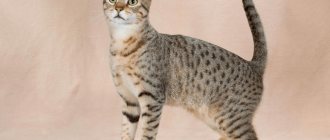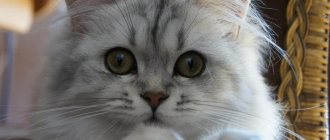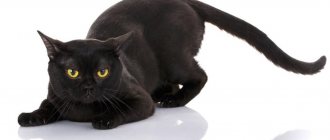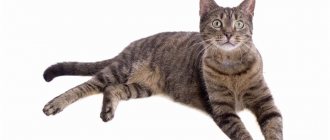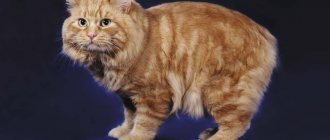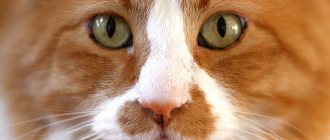The Serengeti is a new breed of short-haired cat that appeared as a result of crossing Bengals and Orientals. Today it is in its infancy. The Serengeti was bred in the USA; in appearance, they resemble the African Savannah cat, but lack the aggression and unwanted instincts of their wild relatives, which makes them comfortable for living next to humans.
History of appearance
The Serengeti breed originated in the USA.
Breeder Karen Sauzman decided to breed a domestic cat with the appearance of a wild beast, a serval. Such attempts have already been made before. For example, savannah. It is a cross between an African bush cat and a domestic cat. But there are difficulties in breeding this breed. Males from the 1st to 3rd generation are born sterile, and subsequent descendants of servals gradually lose their resemblance to the African beast. Sauzman decided to change her approach to crossbreeding. She wanted to get a new breed without the blood of a wild animal. Bengals were crossed with spotted Orientals. This choice was not accidental - Bengal cats passed on to their descendants a large body size and bright color, and oriental beauties shared an elegant appearance, long limbs and large ears, and the spotted print on the coat also did not turn out to be superfluous. Later, the Serengeti cats received the blood of Maine Coons and Abyssinians.
Serengeti looks like a wild cat
The result was presented in 1994. A new breed of cat has appeared with the striking appearance of a wild African cat. The breeder gave her a euphonious name - Serengeti. This is the name of a protected area in Tanzania, where a large population of servals lives. The Serengeti cat breed was registered as an experimental felinological organization TICA, but its representatives do not yet have the right to take part in exhibitions and championships.
Table: pros and cons of the Serengeti breed
| Pros of the Serengeti | Cons of the Serengeti |
| Attractive appearance | Too large size for small apartments |
| Easy to care for and unpretentious in food | Experimental breed (work in progress) |
| Good health | Excessive activity and curiosity |
| Friendly and loving character | Talkativeness of animals (can tire owners) |
| Unexcitable and confident temperament | Rarity and high price of real Serengeti |
| Attachment to home and lack of tendency to wander | Inability to participate in exhibitions (not recognized by all felinological organizations) |
Appearance
If we take the external description of the Serengeti, they are very similar to the serval. They have a muscular body, long legs and neck, and large ears. Silky wool most often has a spotted color.
Serengeti cat color
The coat of Serengeti cats has a honey, smoky or gray background color with beautiful spots of chocolate or black. The breed standard identifies the main colors, which are called:
- black spotted tabby (contrasting spots);
- black ghost spot;
- smoky or gray ghost spotting.
The spots should be horizontal, round and slightly elongated; the presence of a dark path from the inner corners of the eyes is welcome.
The coat color of the new breed is truly exotic
Dimensions and anatomical features
The average weight of cats is from 8 to 10 kg, cats can reach 15 kg. Height is about 60 cm.
The head of the Serengeti is elongated, it expands evenly from the nose to the base of the ears. Cheekbones and cheeks are practically not prominent; the profile is a straight line from the nose to the eyebrows. The chin is clearly defined, the nose is moderately wide, often with a black edging. The neck is long, rather thick, expanding from the head to the body.
The ears of this breed are very large, almost as long as the muzzle, set vertically, set high on the back of the head close to each other. They are wide and deep at the base, the tips are rounded.
The Serengeti has large round eyes, the distance between them is slightly larger than the size of one eye. The preferred color is golden or yellow, light green or hazel is acceptable.
The photo shows that the Serengeti cat is a large animal
Serengeti cats have a strong, long body, a straight line of the back and hips, and shoulders that are approximately the same width as them. The legs are very high, strong and muscular, with medium-sized oval-shaped paws. The tail can vary in length from medium to short, but the preferred size is up to the animal's shoulder. The shape of the tail is wide at the base, tapering towards the end, the tip is always black.
How to buy
A Serengeti kitten must be purchased from a cattery. Unfortunately, today, only American establishments that have proven themselves to be the best are recommended.
Of course, you can try to buy the baby from your own hands, but there will be no guarantee of pure blood.
The price for a Serengeti cat is not less than 400 thousand rubles and can rise to 150 thousand. Their cost depends on origin, color and purpose.
Character
Serengeti cats are very talkative cats. The talkativeness of this breed is their specific feature. They can follow their owner and purr, mumble, click and coo. Sometimes this, of course, is tiring, but you will not be able to convince the cat to remain silent.
The Serengeti cat is quite stubborn. If she wants something, then there is no point in hiding it in the farthest room. Because the Serengeti will overcome all obstacles, and the treasured thing will end up in its muscular paws. To divert your cat's attention from valuable interior items, provide her with a sufficient number of toys.
Serengeti are talkative, stubborn and very brave
Fearlessness is another trait of the Serengeti cat. They, as descendants of wild animals, are not afraid of any street dogs. The cat has a fighting character, so do not let the animal walk alone on the street - suddenly it will encounter an opponent that is too tough for it, or rather, too strong for it.
The Serengeti has strong leadership qualities. In the Serengeti house there is a leader. And if the owner accepts such leadership of the breed, then he is rewarded with its tenderness and kindness.
Feeding the cat
The Serengeti eats both industrial and natural food with equal appetite. Many breeders prefer to give cats of this breed premium or super-premium drying, which is enriched with amino acids, vitamins and microelements.
Best suited for feeding the Serengeti:
- Hills;
- Royal Canin;
- Farmina;
- Acana;
- Grandorf.
With a natural type of nutrition, the basis of a spotted cat’s diet should be meat, offal and ocean fish. It is also advisable to diversify the Serengeti menu with porridge, quail eggs, sour milk and boiled vegetables.
In order not to provoke the development of gastrointestinal diseases, pork, river fish, fresh milk, baked goods, smoked meats, sweets, sausages and any food from the owner’s plate are permanently excluded from the diet of representatives of the breed.
Maintenance and care
There are no special nuances in terms of caring for the Serengeti. It does not leave much fur on the floor, and to collect the falling out undercoat, it is enough to comb the cat every day with a special massage mitt or brush.
Cats of this breed are very clean; they independently remove dirt from their eyes and ears. The main thing is to regularly examine your pet for parasites or unusual changes (for example, redness).
Serengeti are clean and do not leave much fur.
To solve the issue of claw care, just buy a scratching post and place it in a visible place. Also, if possible, it is worth equipping the animal with slides, swings, and a cat tree. Otherwise, the cat will find an opportunity to play by jumping from cabinets onto curtains, tables and other things. She loves secluded places where she can rest quietly, and therefore it is often difficult to find her in the house - the Serengeti is so reliably hidden.
Choosing a kitten
There are only 2 nurseries in Russia that breed this breed, and both are located in the capital: “Russicurl” and “Russicats”. Abroad, the Serengeti can only be purchased in Australia, Great Britain and the United States. Officially registered breeders have a TICA certificate. The absence of such a document indicates that under the guise of an exotic and rare pet, unscrupulous breeders can sell a cat of a different breed. That is why it is strongly recommended to purchase kittens from proven and reliable breeders. The average cost is 40–80 thousand rubles. The price cannot be lower since the breed is very valuable and rare.
When choosing a kitten, you need to pay attention to its appearance. Discharge near the corners of the eyes, plaque on the ears, excessive thinness, a bloated tummy, inertia and lethargy - all this indicates that the baby has health problems. You should buy the most active, playful, agile and friendly pet.
Serengeti kittens have the following distinctive external features:
- large erect ears;
- characteristic “leopard” color with dark rings on the tail and limbs;
- wedge-shaped head;
- a long tail.
However, even if the pet visually meets the breed standard, you still need to check the documents in order to buy a purebred representative and not a half-breed. By the way, a fourth-generation outcross baby is considered a purebred (and therefore the most expensive).
Kittens are usually purchased at the age of 2.5 months. By this time, they have already become sufficiently strong physically and mentally, so they are ready to move to a new family.
Before purchasing a Serengeti, adequately assess your capabilities. Representatives of the breed are quite large, so they will feel cramped in a small apartment. The best option is a private house with a garden plot. There the animal will have the opportunity to frolic in the fresh air and throw out all its energy. If you live in an apartment, you will have to walk your pet outside regularly. When purchasing, be sure to ask the breeders about the diet and purchase the same food. Buy toys, a bed and a tray in advance. Sometimes some of the listed items are given to new owners by breeders to make it easier for the baby to adapt to new conditions.
Video: Serengeti kittens
Nutrition
If you make a choice in favor of industrial feed, then representatives of the Serengeti breed should be fed ready-made dry mixtures of the super-premium or holistic class. They are well saturated and contain various vitamins, minerals and amino acids. Since these are large animals, they need to receive approximately one and a half times more calories than representatives of other breeds.
An adult cat should be fed 2 times a day at the same time, and kittens, depending on age, from 3 to 5 times a day.
Serengeti cats require more food than regular cats
Among the owners of purebred cats, there are those who prefer to prepare their diet from natural products. In this case, 70–80% of the total food volume should be meat and offal. Choose low-fat varieties - poultry fillet, beef tenderloin, veal, rabbit. Heart and stomachs can be given 2 times a week.
The remaining 20% of the diet is supplements, such as cereals, vegetables, eggs, and dairy products. You can treat your pet to a piece of cheese, shrimp, fish, and liver once a week. It is forbidden to feed cats fried, spicy, salty foods, sweets, bones, mushrooms, beans, and bread. Don't give bones or whole milk.
List of vaccinations
To avoid dangerous diseases, pets must be vaccinated. If you adopt a cat from a cattery, most of the vaccinations have already been completed. In this case, a list of further vaccinations is given, if necessary.
If you buy a kitten from your own hands, then it needs to be vaccinated:
- against helminths and other parasites;
- complex vaccination against rhinotracheitis, calicivirus;
- repeat complex vaccination (2 times);
- against rabies.
Further vaccination is carried out according to the schedule. Vaccination against parasites is carried out as needed, the rest – once a year.
Health and life expectancy
Serengeti cats are predisposed to developing urolithiasis. In order not to miss the onset of the disease, you should remember that kidney disease in cats is much less common than in cats. It is also almost impossible to discern the first symptoms. The malaise appears immediately and suddenly.
Suddenly, a Serengeti cat cannot go to the litter box for a long time, begins to lick the opening of the urethra and meow pitifully, unexpectedly urinates in the wrong places, and so on. Self-medication is pointless; only a veterinarian can stop the problem. The veterinarian will also advise what to feed your pet to avoid such diseases.
Otherwise, the Serengeti is a cat of good health. The way the Serengeti looks completely determines its well-being. If she is active and cheerful, then everything is fine.
The breed has excellent health
The lifespan of a cat of this breed is about 10 years.
Photo of the Serengeti cat and description of the exterior
Although the Serval has nothing to do with the origin of the Serengeti, they are quite large cats weighing about 10–12 kg. Females are slightly smaller and more graceful than males.
Let's look at the main features of the exterior:
- a modified wedge-shaped head with poorly defined cheekbones and cheekbones;
- the eyes are large, widely spaced with an amber-golden iris, hazel and light green shades are allowed;
- the ears are erect, large, with a wide base and rounded tips, ideally if their length is comparable to the height of the muzzle;
- on the outer side of the ears there is a light spot in the form of a fingerprint;
- strong chin;
- the bridge of the nose is quite wide, smoothly transitioning to the forehead, without a pronounced stop;
- strong neck of medium length;
- the body is elongated, strong, with a straight back line and a well-developed chest;
- The width of the shoulder girdle and croup is approximately the same;
- the legs are very long, slender, but strong;
- medium-sized oval paws;
- the preferred length of the tail is up to the shoulder, but deviations in one direction or another are possible, the base of the tail is wide, the tip is narrow, colored black;
- The coat is short, very thick, shiny, and silky to the touch.
The Serengeti cat has 4 color types - black smoke spotted, black tabby, silver tabby and brown tabby.
Serengeti on a tree
Exterior disadvantages:
- stockiness, short legs;
- spots on the body in the form of rosettes;
- small ears;
- stripes on the sides of the body;
- too massive or small body.
Breeding
Large cats mature a little later than other breeds. Thus, the first heat of a Serengeti female begins at 8 months, but individuals who have reached one and a half years of age are allowed to mate. Representatives of this breed can be crossed with each other, and mating with Bengals, Orientals and Abyssinians is also allowed. However, the Serengeti cannot be crossed with servals and wild cats. Kittens from such litters will not resemble this breed or will be infertile.
The date for the animals is arranged on the cat's territory. The animals get to know each other for about a day, and then begin mating games. Pregnancy lasts approximately 65–66 days. Kittens are born large - weighing 120–140 g. There are 3–5 cubs in one litter. Breeders hand over babies to new owners at the age of 3–4 months. Vaccination, training kittens to a tray and a scratching post falls on their shoulders.
Such cats grow up quite late
You cannot breed a cat more than once a year. Pregnancy and lactation greatly deplete the body. Full recovery takes on average 10 months.
Castration and sterilization
If the owner does not have serious plans to breed the Serengeti breed at home, then it is better to castrate the pet. This way you will be able to avoid marks of your apartment, screams and inappropriate behavior of the cat. At the same time, an animal deprived of sexual instincts and the regular hormonal surges associated with this becomes more intelligent, calm and happy, while being in the grip of unsatisfied desires, it experiences unnecessary torment. Some owners in vain compare instincts with human feelings, believing that castrated cats are deprived of love. This is not love, but a physiological process of mating based on instincts, and cats can do just fine without it. Moreover, sterilized animals suffer less from cancer and live longer.
At what age is it recommended to have surgery?
Doctors recommend castrating the animal at 7–9 months. On the one hand, at this age the body is already sufficiently formed, on the other hand, the process of puberty has not yet been completed. It is advisable to perform the operation on a cat before the first heat or immediately after it. Some breeders castrate their pets much earlier, before the age of 3-4 months, and claim that information about the dangers of early castration of animals is classified as outdated myths.
Castration can be performed at home or in a clinic. Thanks to modern advances in medicine, the operation is quick and does not pose a threat to the health of the animal. If you castrate an adult animal that has already shown signs of sexual behavior, some of this behavior may persist after the operation. That is, the cat can continue to mark corners in the apartment or organize concerts. To avoid this, castration must be carried out in a timely manner.
Caring for your pet after surgery
The operation is performed under anesthesia and the owner’s main task is to monitor how the animal wakes up and behaves after anesthesia. If you are cold, warm them up and give them drinks in small portions, but feeding them on the day of surgery is not recommended - this can cause vomiting. If your pet persistently licks the wound, you will have to put on a special collar (Elizabethan) and wear it for at least two or three days, until the incisions heal.
The seams will need to be treated for several days with products recommended by a veterinarian - most often this is ordinary brilliant green. Nowadays they use self-absorbing sutures, so they don’t even need to be removed. In about a week the animal will fully recover.
Buying a Serengeti kitten
Kittens are given to a new family from 3 months. You can choose a Serengeti kitten based on the following criteria. They must have:
- large, straight and high-set ears with rounded tips
- the distance between the eyes is greater than the length of one eye, the eyes themselves are large, almost round, curious;
- drawing, if any, is only spotted tabby;
- Long neck;
- thin tail with a rounded tip;
- the coat should not fit very tightly to the body, there should be little undercoat;
- very long legs;
- absolutely straight back line;
- playfulness, fearlessness, curiosity and high mobility.
The photo shows a Serengeti kitten, ready for a new family.
Catteries where you can buy Serengeti kittens exist in Russia, Europe, America and Australia. There are no more than 1000 such cats in the world. Their price can vary from $500 to $3000.
Where to buy a Serengeti kitten
The Serengeti is a breed that is rapidly gaining popularity, all thanks to its wild appearance and sweet disposition. Buying a purebred kitten is difficult, but possible. The largest number of nurseries is concentrated in the USA; a few breeders live in the UK, Australia, Latvia and Russia. Considering the fact that the Serengeti originates from the crossing of Bengals and Orientals, it is not surprising that nurseries usually deal with these three breeds at the same time and it is advisable to buy a baby from one of these.
Serengeti breeders must be officially registered with TICA. Today it is the only one that recognizes the Serengeti breed and issues documents of origin.
Price
Serengeti kittens cost on average from 30,000 to 65,000 rubles. Very rarely less. Individual very promising babies or cats with beautiful clear colors may cost more. Basically, kittens are sold to those who agree to participate in further breeding work. If for some reason the animal cannot participate in breeding, they are sold cheaper, stipulating the need for further castration/sterilization.
Peculiarities
Work on the breed has not yet been completely completed, but the appearance of the cat, indeed, has already absorbed everything characteristic of a serval:
- short hair;
- spotted pattern;
- long legs;
- oval-shaped paws with clenched toes;
- big ears;
- solid weight;
- developed muscles.
The overall expressiveness and sophistication of the Serengeti make the appearance harmonious. The average weight of a cat is 10 kg, the weight of cats is 15 kg. Height is approximately 60 cm. The cat's head is wedge-shaped, without highlighting the cheeks and cheekbones. The nose is indicated by a black border. The long neck has a wide base. The ears are unusually large and protruding.
Interesting Facts
The intelligence and character of the new breed of cats are no less significant than the unique color of the predatory serval. Evidence of extraordinary ability manifests itself in different ways:
- in the talkativeness of cats - in addition to the traditional meow, animals can growl, yelp, tweet, coo, and coo. Serengeti do not make sounds when communicating with animals, but comment on events or enter into conversation with the owner, trying to explain something in their own language;
- in the ability to understand cause-and-effect relationships. Many cats drink tap water, but the Serengeti opens and closes it;
- in the courage of animals. Unlike ordinary purrs, domestic servals will not run away from the enemy, but will get involved in battle. The Serengeti cat will desperately protect an owner who is in danger.
The pet's loving heart has already conquered thousands of people. But the true popularity of the new breed is yet to come.
Serengeti (cat): keeping at home
These unpretentious and sociable animals can easily live in city apartments. But it is not entirely correct to keep the Serengeti in a confined space. They need a place where they can release their pent-up energy. These cats are not afraid of street noise and quickly get used to a leash. Therefore, it is advisable to walk them in the nearest park. Owners of private houses can let their pets into the yard. Representatives of this breed are well versed in the area, do not get lost and are not prone to wandering.
The Serengeti should have plenty to do. Special play complexes can be equipped for them so that the pets have a place to climb and jump. To avoid minor pogroms, small items, flower pots and fragile vases should be removed from the animal’s reach.
Appearance
It is enough to look once at a photo of a Serengeti cat, and it will be difficult to confuse this breed with any other. The Serengeti can rightfully be considered the owner of the title of the longest legs and locator ears among domestic cats.
The Bengals inherited their large eyes and spotted color, the Abyssinians inherited sophistication and plasticity.
Because of the large protruding ears, it seems that the cat is always alert and attentive.
Distribution and abundance
Despite the fact that the Serengeti is a relatively young cat, it is already recognized by the international association TICA. This breed fully complies with all standardization requirements and has already gained popularity among world felinologists.
Today there are about nine hundred such beauties on the planet. Moreover, several of them live in Russia. They say they belong to Muscovites and were purchased for fabulous sums. For those who are interested in how much a Serengeti cat costs, let us tell you that this is a rather expensive pleasure that not every person can afford. The price for such an animal varies from 30 to 70 thousand rubles. Since representatives of this breed are distributed mainly abroad, foreign breeders usually sell them after sterilization and castration. This is done to prevent further popularization of these animals.
